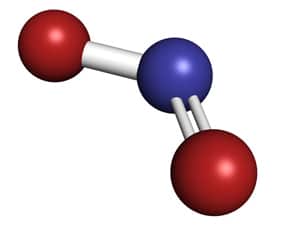
How It’s Used
Nitrogen dioxide (aka nitrogen peroxide) exists in equilibrium with its dimer dinitrogen tetroxide. It presents as a reddish brown gas or yellowish-brown liquid when cooled or compressed. The compound is an intermediate in nitric acid production; a nitrating agent in explosives; a polymerization inhibitor for acrylates; and an oxidizing agent in rocket fuels. Nitrogen dioxide has also been used to bleach flour.
Occupational Health/Toxicology
Nitrogen dioxide irritates mucous membranes, inciting cough and dyspnea. Higher concentrations produce changes in lung function in healthy subjects and lesions in the pulmonary tract of animals. In addition, high levels can interfere with the ability of the blood to carry oxygen—causing headache, fatigue, dizziness, and a blue color to the skin and lips (methemoglobinemia). Repeated exposure to high levels may lead to permanent lung damage.
Full record on nitrogen dioxide from Hazardous Substances Data Bank (HSDB), a database provided by the US National Library of Medicine.
The nitrogen dioxide entry from NIOSH’s Pocket Guide to Chemical Hazards.
Monitoring Instrumentation
Check out Interscan’s full line of nitrogen dioxide gas detection/gas monitoring instrumentation.
